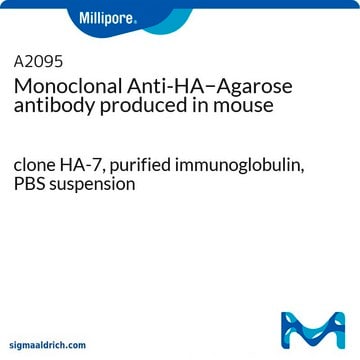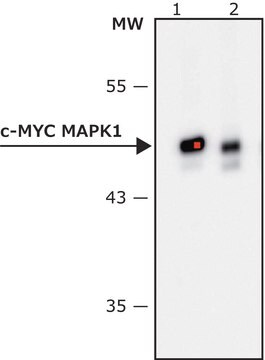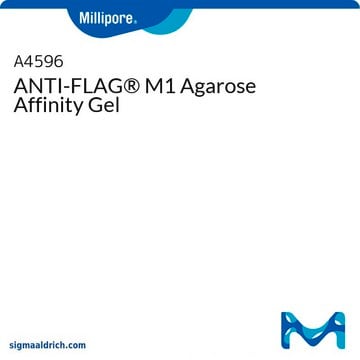16-219
Anti-Myc Tag Antibody, clone 4A6, agarose conjugate
clone 4A6, Upstate®, from mouse
About This Item
Produits recommandés
Source biologique
mouse
Niveau de qualité
Forme d'anticorps
purified immunoglobulin
Type de produit anticorps
primary antibodies
Clone
4A6, monoclonal
Espèces réactives
human
Fabricant/nom de marque
Upstate®
Technique(s)
immunoprecipitation (IP): suitable
Numéro d'accès NCBI
Numéro d'accès UniProt
Conditions d'expédition
wet ice
Modification post-traductionnelle de la cible
unmodified
Informations sur le gène
human ... MYC(4609)
Description générale
Spécificité
Immunogène
Application
A previous lot was used to purify Myc-tagged proteins. Elute with 100 mM tetraethyl ammonium (TEA), pH 11.5.
Caractéristiques et avantages
Qualité
Immunoprecipitation Analysis:
4 μg of anti-Myc Tag, clone 4A6, agarose conjugate immunoprecipitated Myc-tagged Akt/PKB from 250 μg of a COS transfected cell lysate, which was then detected by immunoblot analysis, using 0.5 μg/mL of anti-Myc Tag, clone 4A6 (Catalog # 05-724).
Description de la cible
Forme physique
Stockage et stabilité
Remarque sur l'analyse
Cells transfected with Myc-tagged fusion vector.
Autres remarques
Informations légales
Not finding the right product?
Try our Outil de sélection de produits.
Code de la classe de stockage
10 - Combustible liquids
Classe de danger pour l'eau (WGK)
WGK 2
Certificats d'analyse (COA)
Recherchez un Certificats d'analyse (COA) en saisissant le numéro de lot du produit. Les numéros de lot figurent sur l'étiquette du produit après les mots "Lot" ou "Batch".
Déjà en possession de ce produit ?
Retrouvez la documentation relative aux produits que vous avez récemment achetés dans la Bibliothèque de documents.
Les clients ont également consulté
Notre équipe de scientifiques dispose d'une expérience dans tous les secteurs de la recherche, notamment en sciences de la vie, science des matériaux, synthèse chimique, chromatographie, analyse et dans de nombreux autres domaines..
Contacter notre Service technique















